If you want to grow Lisianthus from seed as a cut flower and arrange them in beautiful bouquets, you are in the right place! With our expert guide for cutting flower growers, discover how to grow lisianthus from seed, plugs, and cuttings. Are you captivated by the elegant beauty of Lisianthus flowers? With their rose-like blooms and delicate petals, these stunning blossoms are a true delight in cut flower arrangements and garden beds alike. Lisianthus’s remarkable ability to retain its freshness for 2-3 weeks as a cut flower has undoubtedly contributed to its widespread profitability and appreciation within the floral industry.
For optimal growth in a small flower garden or a large-scale farm, the recommended method involves starting Lisianthus from seed indoors and subsequently transplanting the seedlings to the garden (when the growing zone requires it) or directly growing Lisianthus seeds by sowing them outdoors and overwintering the flower plants if the weather allows.
Cultivating Lisianthus from plugs can be a profitable method, offering its own set of pros and cons depending on your objectives. Additionally, this article explores alternative propagation methods for Lisianthus plants, including cuttings and divisions, providing insights into their respective advantages and disadvantages.
While Lisianthus plants are widely available in nurseries, there’s something incredibly rewarding about growing them from seed. In this comprehensive guide, we’ll walk you through the process of nurturing these gorgeous flowers from the tiniest of seeds to magnificent, long-lasting blooms.

Table of Contents
What is Lisianthus?
Lisianthus, scientifically known as Eustoma grandiflorum, is a flowering plant native to the United States and Mexico. It is also known as prairie gentian or Texas bluebell. These delicate beauties belong to the Gentianaceae family. They are prized for their stunning, rose-like blossoms, which come in a wide array of colors, including white, pink, purple, and bicolor options.
With their long, sturdy stems and vase life of up to two or three weeks, Lisianthus flowers are a favorite among florists, cut flower growers alike, and customers. For instance, Dahlias usually maintain their freshness for 3-5 days in a vase, whereas Snapdragons, Feverfew, and Lisianthus can retain their appeal for up to 21 days. A “good vase life” is generally deemed to be 5-7 days.
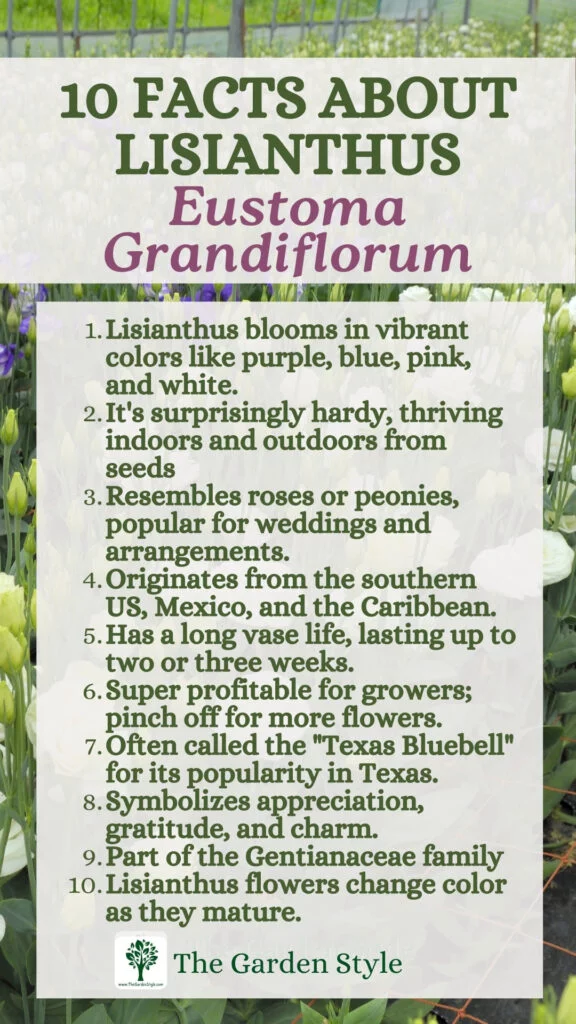
Growing Lisianthus from Seed vs. Planting Plugs
Let’s see why you should grow Lisianthus from seed. While you can purchase Lisianthus plants from nurseries, growing them from seed offers several advantages. First and foremost, it’s incredibly cost-effective, allowing you to cultivate a wide variety of colors and cultivars at a fraction of the cost. Additionally, sowing seeds yourself gives you the satisfaction of witnessing their growth from the earliest stages, nurturing them through each phase of development. Moreover, seed-grown Lisianthus plants often produce more robust, longer-lasting blooms than their nursery-bought counterparts.
No doubt, it is a perfect cut flower. However, growing Lisianthus may not be as easy as growing other cut flowers such as Zinnias and Cosmos. They are extremely slow growers. So, pay attention as I try to explain and add as many growing tips as I can.
Many growers order lisianthus plugs online instead of starting their own seeds. What is a Lisianthus plug? It’s a nursery-raised seedling that you can still grow indoors when it arrives or harden off and plant in the ground if weather conditions are suitable. Purchasing Lisianthus plugs will save you from dealing with starting seeds. So, if you prefer, you can plant Lisianthus plugs and grow them in that way. However, growing lisianthus from seeds is a more cost-effective way to have a cut flower garden on a budget, and you may not have to deal with common fungal infections.
When cultivating lisianthus plugs, Fusarium disease is the most frequent issue due to increased humidity conditions during transportation. Although easy to prevent! For profitable Lisianthus cultivation, it’s advisable to pre-treat Lisianthus seedlings and plugs with a bio-fungicide just before transplanting to shield them from fungal infections like Fusarium. Even healthy-looking plugs can harbor fungal spores in the soil.
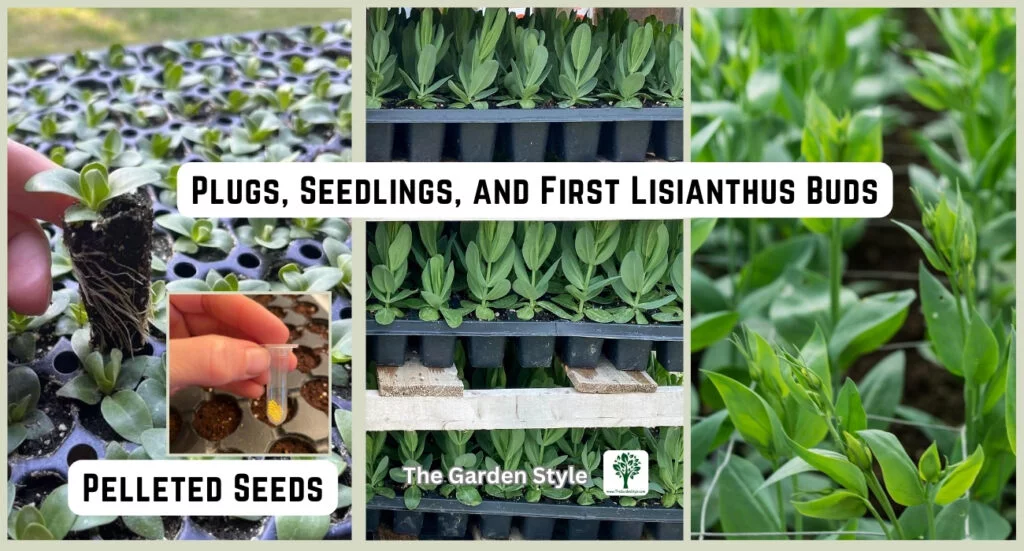
If you are running a flower farm, the better approach is to start lisianthus from seeds rather than purchase plugs online. Growing lisianthus from seed offers several key advantages: It’s incredibly cost-effective, allowing you to cultivate a wide variety of colors and cultivars at a fraction of the cost compared to purchasing plugs.
Sowing seeds yourself also gives the satisfaction of nurturing the plants through each stage, from the earliest phases of germination. Moreover, seed-grown lisianthus plants often produce more robust, longer-lasting blooms than nursery-raised plugs.
So, for budget-conscious cut flower growers, while plugs are an option, growing vigorous lisianthus crops from seeds tends to be the more profitable and rewarding route in the long run.
Preparing for Lisianthus Seed for Sowing
Choosing the Right Lisianthus Seeds
Quality is key when selecting Lisianthus seeds. Look for reputable seed suppliers that offer a diverse range of cultivars, from classic single blooms to ruffled, double varieties. Pay close attention to the seed packet information, including bloom time, plant height, and any specific growing requirements.
Lisianthus seeds are extremely tiny, so they are usually supplied as “pelleted” seeds coated to facilitate handling.

Lisianthus Variety Series Chart
Here’s a table summarizing the key characteristics of each Lisianthus variety series, including flower type, plant height, stem length, days to bloom, and available colors.
| Variety Series | Flower Type | Plant Height | Stem Length | Days to Bloom | Colors |
| Eco Series | Single, Rose-Shaped | 24-28 inches | 12-16 inches | 120-150 days | Various shades including White, Pink, Purple, Green, and Bicolors |
| ABC Series | Highly Double | 28-32 inches | 16-20 inches | 120-150 days | Various shades, including White, Blue, Pink, Yellow, and Lavender |
| Mariachi Series | Semi-Double, Ruffled | 24-28 inches | 14-18 inches | 120-150 days | Various shades, including Bright Reds, Oranges, and Yellows |
| Opus Series | Double, 4+ Inches | 32-40 inches | 20-28 inches | 120-150 days | Various shades, including White, Pink, Purple, Yellow, and Bicolors |
| Doublini Series | Dwarf Double | 12-18 inches | 8-12 inches | 90-120 days | Various shades, including Blue, Pink, White, and Yellow |
| Magic Series | Singular, Twisted Petals | 28-36 inches | 18-24 inches | 120-150 days | Various shades, including Purple, Green, Blue, Lemon, and Rose |
Late varieties bloom later and have longer stems (Group 3).
Germination Requirements
Lisianthus seeds are notoriously tricky to germinate, but with the right conditions, you can achieve excellent results. These seeds require light to germinate, so they should be sown on the surface of the soil mix and lightly pressed into the medium. Additionally, for optimal germination, Lisianthus seeds prefer consistent moisture and warm temperatures between 70°F and 75°F (21°C and 24°C).
To reach the seedling-plug stage, starting Lisianthus from seed requires providing perfect conditions for about 12 weeks, which is difficult for home growers.
- Temperature: 70-75°F (21-24°C)
- Light: Seeds require light for germination
- Humidity: Consistent moisture/high humidity (70%)
- Sowing Depth: Surface sown, seeds pressed into medium
- Soil: Well-draining seed starting mix
- Soil pH: 6.0-6.8 (slightly acidic) for optimal germination and seedling growth.
- Duration: 10-14 days typical for germination
- Duration plug stage: about 12 weeks
Lisianthus Zones
Let’s see what the USDA hardiness zones are suitable for growing Lisianthus from seed and when it should be sown.
Not sure about your USDA hardiness zone? No problem! Simply enter your ZIP code in the field below, and we’ll instantly display your corresponding growing zone. It’s important to note that the USDA hardiness zone map underwent updates in 2023. Our user-friendly online tool makes it easy to identify your accurate USDA hardiness zone based on the latest information.
Just type in your ZIP code below, and let us do the rest. Knowing your precise hardiness zone is crucial for selecting plants that thrive in your local climate conditions.
Lisianthus is typically grown as an annual or biennial in most regions, but it can be perennial in USDA hardiness zones 8 and above. Most gardeners treat it as an annual and grow it from seed each year. Depending on the climate and the desired timing of bloom, you can germinate Lisianthus seeds indoors or directly sow them outdoors.
USDA Hardiness Zones: Lisianthus is generally suitable for perennial growth in USDA hardiness zones 8 and above. However, it can be grown annually in cooler climates by sowing seeds indoors and transplanting after the last frost date.
Sowing Time: In cooler climates (zones 7 and below), Lisianthus seeds can be sown indoors 8 to 10 weeks before the last frost date. In warmer climates (zones 8 and above), Lisianthus seeds can be sown outdoors in late winter to early spring or in early fall for winter blooms.
Indoor Sowing
- Start Lisianthus seeds indoors 8 to 10 weeks before the last frost date. If the frost calendar is not consistent, you can transplant them up to the 12th week.
- Use a well-draining seed-starting mix and provide bottom heat to aid germination.
- Lisianthus seeds need light to germinate! They require 12 hours of light.
- Transplant seedlings outdoors after the danger of frost has passed and the soil has warmed up.
- To get a jump start on earlier blooms, start Lisianthus seeds indoors about three months before the last expected frost.
Direct Outdoor Sowing
- In warmer climates (zones 8 and above), Lisianthus seeds can be sown directly outdoors in the garden in late winter to early spring or in early fall once the soil has warmed up.
- Sow seeds at a depth of about 1/4 to 1/2 inch (0.6 to 1.3 centimeters) deep and keep the soil consistently moist until germination occurs.
- Wait at least 1-2 weeks after the last expected frost date in spring
Regardless of the sowing method, Lisianthus seeds require warm soil temperatures around 70-75°F (21-24°C) and light for optimal germination.
By starting seeds indoors, you’ll get a head start and can enjoy earlier blooms. However, direct sowing outdoors can also be successful if appropriately timed for your climate.
Seed Starting Soil Mix and Containers
To ensure strong, healthy growth, choose a well-draining seed-starting mix or prepare your own by combining equal parts of peat moss, vermiculite, and perlite.
Regarding containers, Lisianthus seeds can be sown in seed trays, cell packs, or individual containers as long as they have good drainage holes. Also, you can successfully grow Lisianthus in containers if you have a small backyard. No problem at all! Just keep space between the plants, as I explain in the following sections, because properly spacing them is the key to a healthy and blooming Lisianthus plant.
Here is a good seed starting mix composition for germinating lisianthus seeds:
Lisianthus Seed Starting Mix Recipe
- Sphagnum Peat Moss – 4 parts
- Vermiculite or Perlite – 2 parts
- Aged Compost or Worm Castings – 1 part
- Horticultural Sand or Grit – 1 part
That creates a light, well-draining mix with good aeration and water retention capabilities. The components:
- Sphagnum Peat Moss: The peat base provides moisture retention while allowing airflow.
- Vermiculite or Perlite: These amendments enhance drainage and aeration in the mix.
- Compost/Worm Castings: Adds mild nutrients and microbial activity.
- Sand/Grit: Improves drainage and helps prevent compaction.
You can also add a small amount (1 tsp per gallon) of dolomitic lime to raise the pH to that ideal 6.0-6.8 range for Lisianthus.
This style of light, fluffy, pathogen-free mix provides the perfect environment for optimal lisianthus seed germination when paired with the right temperature, moisture, and light conditions.
Here are the steps to start Lisianthus seeds indoors and the ideal timing:
When to Start Lisianthus Seeds Indoors
Lisianthus has a long growing season, lasting 20-24 weeks from seed to flower. To get a headstart, sow the seeds indoors 10-12 weeks before your last expected spring frost date.
For example, if your last frost date is around May 1st, you’ll want to sow the Lisianthus seeds indoors around late February to mid-March.
Tips for Growing Lisianthus Seeds
Many flower seeds cannot be directly sown outdoors, but in the case of Lisianthus, they can be started either indoors or outdoors. It’s solely your decision, based on the climate of your region (growing zone) and your purpose.
As I previously mentioned, germinating Lisianthus seeds may be a bit challenging compared with an easy flower such as Zinnias. Just be sure to comply with the following germination requirements:
- Temperature: 70-75°F (21-24°C)
- Light: Seeds require light for germination
- Humidity: Consistent moisture/high humidity (70%)
- Sowing Depth: Surface sown, seeds pressed into the medium
- Soil: Well-draining seed starting mix
- Soil pH: 6.0-6.8 (slightly acidic) for optimal germination and seedling growth. Learn how to measure soil pH.
- Duration: 10-14 days typical for germination
- Duration plug stage: about 12 weeks
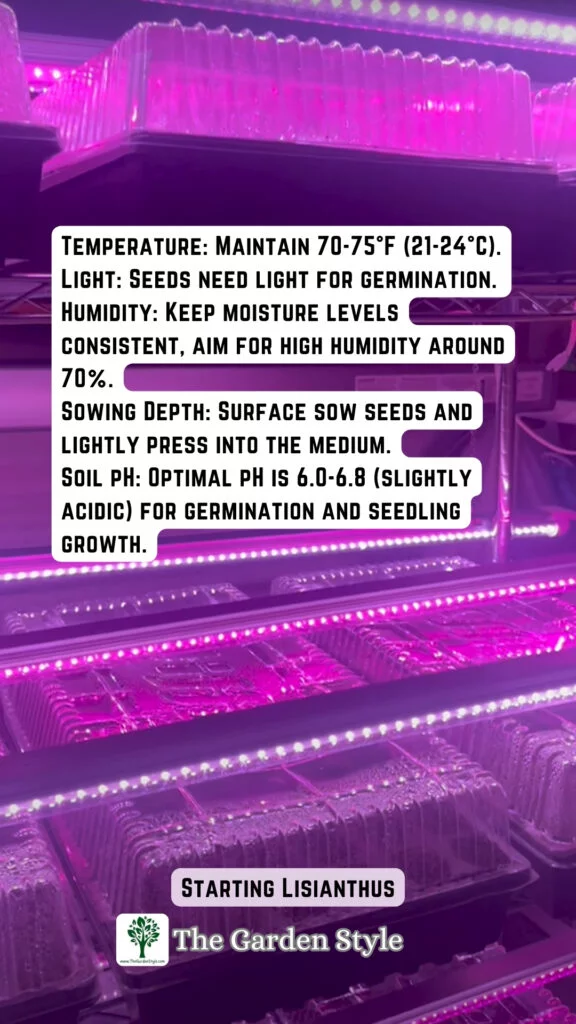
Starting Lisianthus Seeds Indoors
If you need to start Lisianthus seeds indoors, here is a list with the step-by-step process and gardening tips.
Materials Needed
- Seed-starting trays or containers (with a plastic dome as optional)
- Heat mat (optional but recommended)
- Humidity dome or plastic wrap
- Seed-starting mix
- Lisianthus seeds
- Light source (natural sunlight or grow lights)
- Watering spray bottle
- Labels or markers
- Fan (optional but recommended)
Seed-Starting Trays or Containers: Sow Lisianthus seeds in trays or containers with drainage holes. These can be plastic, peat, or biodegradable pots. Germinating Lisianthus and having a seedling takes longer than for other flowers, so I prefer to use a seed-starting tray with a plastic dome. However, it depends on your growing conditions.
Heat Mat with a digital thermostat controller (highly recommended): If your indoor environment is cool, consider using a heat mat to provide bottom heat and promote germination. It will keep your seeds consistently warm, which is definitely needed for these challenging seeds. A digital thermostat controller can save you significant time by automating temperature monitoring.
Humidity Dome or Plastic Wrap: To maintain high humidity levels for germination, cover seed trays with a humidity dome or plastic wrap until seedlings emerge.
I prefer using seedling starter trays equipped with a heating mat and a transparent dome to grow my Lisianthus indoors.
- Premium Material — Made of transparent material, it allows you to carefully observe the trend of seeds growth. The humidity dome is also designed with a vent which allow for oxygen exchange and moisture retention, creating the optimum climatic conditions for your seeds.
Seed-Starting Mix: Choose a sterile, well-draining seed-starting mix specifically formulated for starting seeds. Avoid using garden soil, as it may contain pathogens and weed seeds. You can use my “Lisianthus Seed Starting Mix Recipe” that I just mentioned in the previous section. You may want to use the pH soil measure that also measures humidity.
Lisianthus Seeds: Purchase high-quality Lisianthus seeds from a reputable supplier. Choose a variety that suits your preferences and growing conditions.
Light Source: Lisianthus seeds require adequate light for germination and seedling growth. Place seed trays near a bright, south-facing window or use artificial grow lights to provide sufficient light.
- Full Spectrum – Barrina LED grow lights provides sufficient light for indoor plants, especially blue and red light that perfect for seed germination and leafy plants growing, also work great in bloom and fruit stages.
Watering Spray Bottle: Use a watering spray bottle to water Lisianthus seeds gently. Avoid overwatering, as it can lead to damping-off and other issues.
Labels: Use labels or markers to identify trays and varieties of Lisianthus seeds. This helps you keep track of different varieties and planting dates.
Fan (highly recommended): Using a fan to provide gentle air circulation can help prevent fungal diseases and strengthen seedlings. Lisianthus flowers are very susceptible to fungal infections, and the constant high humidity conditions required for germinating seeds create the perfect environment for that. So, a small oscillating fan is a great help to prevent fungal diseases at this growth stage. The fan also creates a wind effect, useful to harden seedlings before transplanting.
- US Patented Square Design: This patented clamping fan can easily hold tight on round, square poles, and flat surfaces without slipping; Its clamp has a thick rubber pad to ensure it does not slip or scratch surfaces
Step-by-Step
- Use a seed-starting tray or containers with drainage holes and fill them with a sterile seed-starting mix. If the soil is not sterile, I strongly suggest spraying an organic fungicide on it before sowing seeds. I believe this is one of the most common mistakes even in avoiding flower farmers. I recommend taking extra steps at this point instead of wasting the entire production in 12 weeks. Keep that in mind.
- I prefer seed-starting trays with a plastic dome for Lisianthus because it takes more time than other seeds. Do not use self-watering seed trays to grow Lisianthus from seeds.
- Be sure to moisten the seed starting mix thoroughly before sowing the tiny lisianthus seeds on the surface. The seeds are generally pellets for easier manipulation.
- Surface sow the Lisianthus seeds by sprinkling them evenly over the soil surface. Press them gently into the soil, but don’t cover them, as they need light to germinate.
- Lightly mist the soil to moisten it, being careful not to displace the seeds. The mist will gently remove the cover throughout the germination time. Do nothing to speed up the process.
- Cover the trays with a clear plastic dome or plastic wrap to maintain humidity.
- Place the covered trays on a heat mat or warm surface around 70°F-75°F for optimal germination.
- Check daily and mist the soil when the surface becomes dry to keep it evenly moist but not soggy.
- Watering from above is great for creating deep roots, but only once your seedling is about 1 inch (2,5 cm)
- Seeds should germinate in 10-14 days. Remove the cover once most have sprouted.
- Once the seedlings emerge, move them to a sunny window or under grow lights, keeping the soil moist. Before moving them outside, place a small oscillating fan to make them resilient.
A friendly reminder again: you should apply fungicide to the soil when starting seeds (indoors or outdoors) and before planting plugs or seedlings in the growing location. Shield your Lisianthus from Fusarium disease.
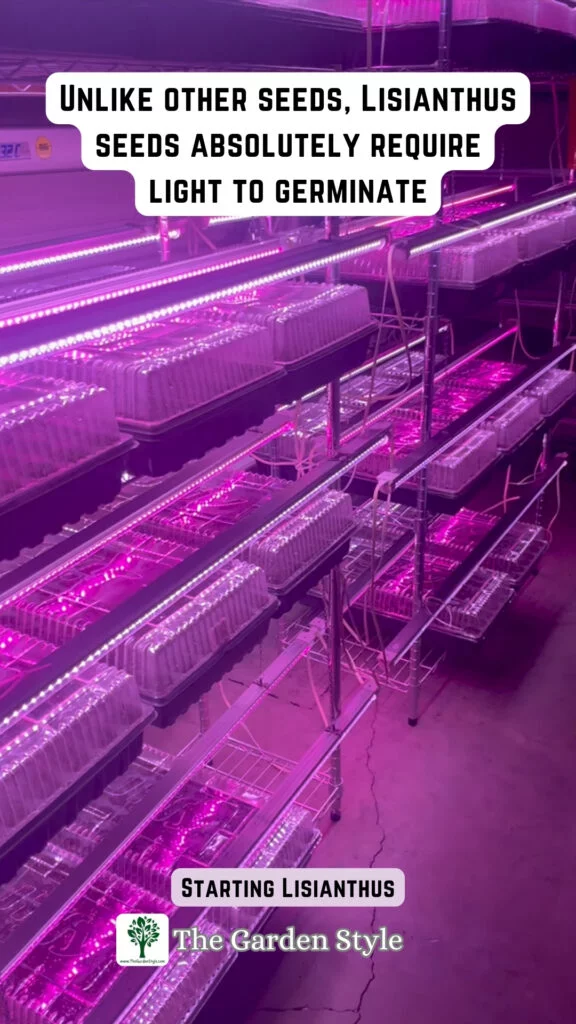
Let’s see the tips for caring for Lisianthus seedlings.
Watering and Humidity for Seed Starting
Consistent soil moisture is crucial during germination (typically 10-20 days) for a successful process. Water the soil mix thoroughly from the bottom, allowing the excess moisture to drain away. Maintain a humid environment by covering the seed tray or containers with a clear plastic dome or wrap until the seeds sprout, which typically takes 10 to 14 or up to 20 days.
Fusarium is one of the most common rot root diseases. The best way to prevent it is always to ensure good air circulation. I like to use a little fan when germinating my seeds. Quickly removing and disposing of any wilted/browning Lisianthus seedlings is essential to limit fusarium spread.
Temperature and Light for Seed Starting
Lisianthus seeds require warm temperatures between 70°F and 75°F (21°C and 24°C) for optimal germination. Once the seeds have sprouted, provide them with bright, indirect light by placing them near a sunny window or under grow lights. Seedlings need bright light (14-16 hours) once they emerge to prevent stretching/weakness.
Gradually expose seedlings to cooler temperatures around 65°F before transplanting.
How Deep and Far Apart To Sow Lisianthus Seeds and Plant Seedlings
As mentioned earlier, Lisianthus seeds should be sown on the surface of the soil mix and gently pressed into the medium. Space the seeds about 1 inch (2.5 cm) apart, as Lisianthus seedlings require ample room to develop strong root systems. Once they have their first set of true leaves, thin out the Lisianthus seedlings to 2-3 inches apart, keeping the largest ones.
The spacing for planting Lisianthus depends on various factors such as the cultivar, intended use (e.g., garden bed, container), and local growing conditions. However, a general guideline is to space Lisianthus plants around 12 to 18 inches (30 to 45 centimeters) apart. This spacing provides enough room for each plant to develop and spread while allowing for adequate air circulation, which can help prevent diseases. If you’re planting multiple rows, space the rows about 18 to 24 inches (45 to 60 centimeters) apart to facilitate access for maintenance and harvesting. Adjustments may be needed based on the specific requirements of your Lisianthus variety and growing conditions.
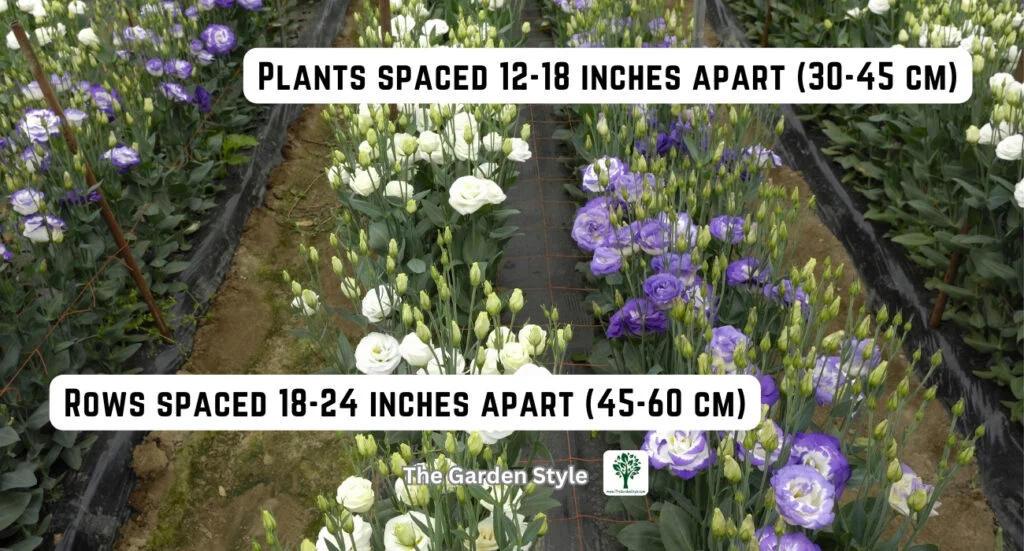
Lisianthus seeds should be sown at a depth of about 1/4 inch (0.6 cm) deep. This depth is suitable for ensuring good soil contact while still allowing the seeds access to light for germination.
When sowing Lisianthus seeds, it’s essential to prepare the seedbed by loosening the soil and removing any debris. After sowing the seeds, lightly cover them with soil, then gently press down to ensure good seed-to-soil contact. Water the area gently but thoroughly after planting to settle the soil and initiate the germination process.
Maintain consistent moisture levels during the germination period, which typically takes around 10 to 20 days, depending on conditions such as temperature and soil moisture. Once the seeds germinate and seedlings emerge, you can gradually reduce watering frequency but ensure that the soil remains consistently moist to support healthy growth.
Lisianthus Sowing Depth and Spacing Chart
| Step | Spacing and Depth |
| Sowing Seeds | Surface sow, gently press into medium about 1 inch apart (2.5 cm) |
| Sowing Depth | Seed depth: 1/4 inch deep (0.6 cm). Do not cover them with soil. |
| Thinning Seedlings | Thin to 2-3 inches apart (5-7.5 cm) |
| Planting Spacing (In-Row) | Plants spaced 12-18 inches apart (30-45 cm) |
| Planting Spacing (Between Rows) | Rows spaced 18-24 inches apart (45-60 cm) |
How To Harden Off Lisianthus Seedlings
Hardening off Lisianthus seedlings is an important step to help them transition successfully from the protected indoor environment to outdoor conditions. Here’s how to properly harden off Lisianthus seedlings before transplanting them into the garden:
- Timing: The seedlings should start hardening off about 7-10 days before you plan to transplant them outdoors. This gradually exposes them to outdoor conditions.
- Temperature: On the first day, take the seedling trays outside and place them in a shaded, sheltered spot. Leave them out for just 2-3 hours, bringing them back inside. Gradually increase their outdoor exposure time each day.
- Direct Sunlight: After 2-3 days of hardening off in the shade, begin exposing the seedlings to direct morning sun for 1-2 hours, increasing the duration daily.
- Wind Exposure: Place a small fan near the seedlings indoors and periodically blow it gently on them. This mimics outdoor wind and strengthens their stems.
- Moisture: Allow the soil to dry out slightly between waterings during the hardening-off period. This prepares them for drier outdoor conditions.
- Protection: If nights are cool, cover the seedlings with a cold frame, cloche, or floating row cover overnight when outside.
- Transplanting: After 7-10 days of gradually introducing outdoor conditions, the Lisianthus seedlings should be ready for transplanting into the garden.
The key is to make the transition from indoors to outdoors slowly over 1-2 weeks. This allows the tender seedlings to adjust to sunlight, wind, and temperature fluctuations, and dry out without shock. Properly hardened off seedlings will be stockier, sturdier, and better able to thrive when transplanted into the garden.
Thinning and Transplanting Lisianthus Seedlings and Plugs Outdoors
Remember to harden off seedlings for 7-10 days before transplanting outside after the danger of frost has passed.
As the Lisianthus seedlings develop their first set of true leaves, it’s time to thin them out. Gently snip off the weaker seedlings. Once the seedlings have developed a robust root system, transplant them into larger containers or directly into the garden.
Transplanting seedlings and plugs at the right time is critical. Lisianthus prefers cool soil temperatures below 55°F for the first 2-3 weeks after transplanting before warming up.
Space Lisianthus 8 plants per square foot. So, a general guideline is to space Lisianthus plants around 12 to 18 inches (30 to 45 centimeters) apart. This spacing provides enough room for each plant to develop and spread while allowing for adequate air circulation, which can help prevent diseases. If you’re planting multiple rows, space the rows about 18 to 24 inches (45 to 60 centimeters) apart to facilitate access for maintenance and harvesting.
When growing Lisianthus for profit, I recommend pretreating seedlings with biofungicide just before planting them out, as it is essential to protect them from fungus. Then, choose a full sun and well-draining location.
Before transplanting them, don’t miss the next section about Lisianthus companion planting. Keep reading!
How to Amend Clay and Sandy Soil for Growing Lisianthus
In both clay and sandy soil, proper soil preparation and amendments can create more favorable growing conditions for Lisianthus.
Lisianthus generally prefers well-draining soil with good fertility. While it can tolerate a range of soil types, including clay and sandy soil, some adjustments may be necessary to optimize growing conditions:
Amending Clay Soil
Lisianthus can grow in clay soil, but the heavy, compact nature of clay can lead to drainage issues and waterlogged conditions, which may not be ideal for Lisianthus. To improve drainage in clay soil, incorporate organic matter such as compost or aged manure into the soil before planting Lisianthus. This helps to loosen the soil structure and enhance drainage.
Amending Sandy Soil
Sandy soil drains quickly and may not retain moisture and nutrients well, which can pose challenges for Lisianthus. To improve sandy soil for Lisianthus cultivation, amend it with organic matter such as compost, peat moss, or well-rotted manure to increase moisture retention and fertility. Additionally, regular deep watering and mulching can help conserve moisture and maintain soil fertility in sandy soil.
Additionally, maintaining consistent moisture levels and providing adequate fertilization can help support healthy growth and blooming, regardless of the soil type.
What to Plant with Lisianthus: Best and Worst Companion Plants for Lisianthus
Here’s a table summarizing the best and worst companion plants for growing lisianthus:
| Best Companions | Benefits | Worst Companions | Issues |
| Marigolds | Repel nematodes, rabbits | Tomatoes | Compete for nutrients, invite pest issues |
| Nasturtiums | Trap crop for aphids | Potatoes | Compete for nutrients, attract pests |
| Alyssum | Living mulch, attracts beneficials. | Brassicas (broccoli, kale) | Attract cabbage worms, flea beetles |
| Cosmos | Provide shade, loosen soil | Fennel | Invasive, inhibits growth |
| Zinnias | Similar needs, bloom times | Mint | Aggressive spreading |
| Borage | Attracts pollinators, pest deterrent | Squash/Pumpkins | Rampant vining, roots compete |
| Dill | Attracts beneficial wasps | Corn | Crop residue harbors pests |
The best Lisianthus companions provide beneficial insect attractants, living mulches, pest deterrents, and soil-improving qualities without excessive competition.
The worst companions include aggressive sprouting plants, large vining crops, nutrient hogs, and plants that attract or harbor pests harmful to lisianthus.
Proper spacing and soil nutrient management are key when companion planting with lisianthus to avoid negative impacts on growth and blooming.
How to Fertilize Lisianthus
Lisianthus plants are heavy feeders, and providing them with the right nutrients is essential for vigorous growth and abundant blooms. Use a balanced, water-soluble fertilizer every two weeks, following the manufacturer’s instructions for dilution rates. Alternatively, you can incorporate a slow-release fertilizer into the soil mix during transplanting.
Organic fertilizers, such as compost, manure, or fish emulsion, are derived from natural sources and provide a slow release of nutrients as they break down in the soil. They improve soil structure and fertility over time and are environmentally friendly. Some growers prefer custom-formulated fertilizers tailored to the specific needs of their cut flower crops. These formulations may include additional micronutrients or organic supplements to address deficiencies or enhance flowering.
For growing cut flowers, including Lisianthus, it’s essential to provide them with the proper nutrients to support healthy growth and abundant blooms. I prefer to choose fertilizers suitable for all my cut flowers, and besides the type selected, I like to use this approach:
- First, use organic fertilizer, such as 8-4-8, containing 8 parts of nitrogen (N), 4 parts of phosphorus (P), and 8 parts of potassium (K) during the early vegetative stage. These fertilizers provide a well-rounded mix of nutrients to support overall plant health and flower production.
- Then, encourage blooms by switching to a formulation with a lower nitrogen content (e.g., 5-10-10 or 5-15-15) or a specialized bloom booster fertilizer with higher phosphorus and potassium formulation (e.g., 0-10-10 or 0-15-15) once budding begins. Phosphorus is crucial for promoting prolific flowering and strong bloom development. These formulations provide the necessary nutrients to support healthy growth and abundant flowering while minimizing excessive vegetative growth. It doesn’t need to be zero nitrogen (just preferred). You may have some other fertilizer formulations well-suited for Lisianthus blooms, such as 9-58-8 (often used for roses), 3-12-12 (suitable to fertilize tomato and zucchini plants), or 15-30-15 (suitable for flowering plants).
It’s essential to note that while a lower nitrogen content is generally preferred for flowering plants, some nitrogen is still necessary for overall plant health. Completely eliminating nitrogen from the fertilizer mix may lead to deficiencies and weakened plants. So, if you are skipping the first fertilizer, such as a commercial formula 10-10-10 or 20-20-20, to jump directly in a 0-10-10 or 0-15-15, be sure to amend the soil with compost or any other organic fertilizer with some nitrogen. An early sign of yellow leaves before blooming indicates a lack of nitrogen that will jeopardize your flower harvest.
I believe one of the most common mistakes of beginner flower farmers is to rely on compost or other organic fertilizers instead of having the best of both homemade and commercial fertilizers.
Pinching and Cutting Back Lisianthus (Should I do it or not?)
If you are a beginner gardener, let me just say that you can pinch off some flowers to increase blooms, but that doesn’t work for all flower types. So, you need to know what plants you can pinch off and how.
Pinching Lisianthus, also known as tipping, consists of removing the growing tip of the main stem. That can encourage lateral branching and ultimately result in more blooms by increasing flower production. However, whether you should pinch your Lisianthus plants depends on various factors, including the desired height (or length of the stem) and the effect of the flowering time.
If your goal is to have a stem Lisianthus for a wholesale market, the minimum stem length is 20 inches, and for premium quality, it is required between 24 and 36 inches.
When you pinch back Lisianthus, you will encourage bushier growth and more flower stems, between 10 to 15 stems per Lisianthus plant. However, they do not necessarily have longer stems, and it will take more time to bloom (about 10 to 15 days). So, keep that in mind before pinching them. Pinching will produce more but smaller stems per plant. I prefer not to pinch, resulting in taller stems with larger flowers.
I’ve had success pinching out the growing tips of Lisianthus plants when they are 6-8 inches (15 to 20 cm) tall.
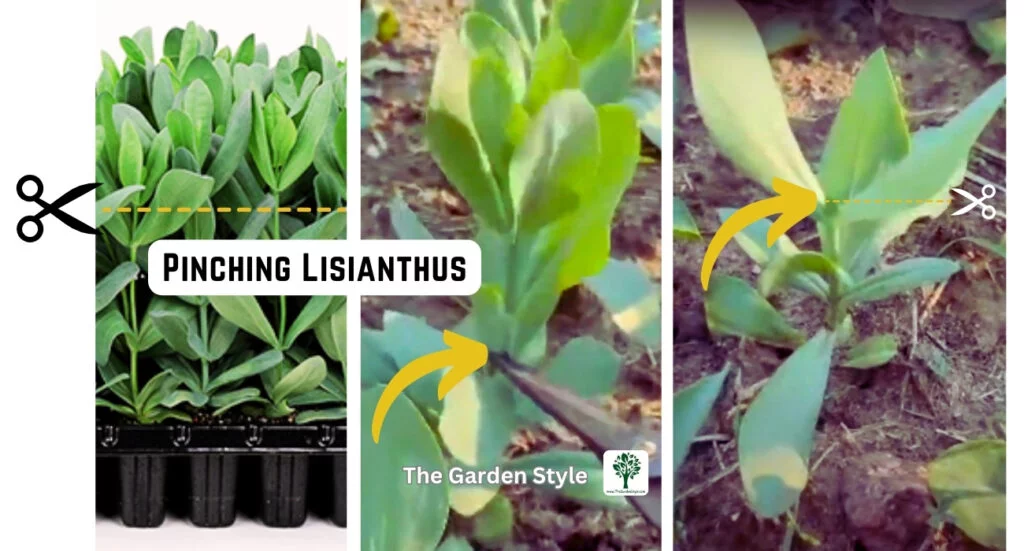
In warm climates, a second or third flush may occur after cutting back the plant. I used to easily have a third round of blooms in Arkansas.
Most Common Mistakes When Growing Lisianthus from Seed
In many instances, I’ve observed buyers complaining about seeds that fail to germinate, leading them to opt for plugs to avoid inconvenience. Typically, they attribute the issue to the seeds themselves.
However, successful Lisianthus germination relies heavily on following the correct steps. Fortunately, I’ve found that Lisianthus seeds marketed in the USA are generally of high quality, and I’ve had no issues growing those sourced from places like the Netherlands. In fact, they are my preferred cultivars, and they are especially suitable for the wholesale market.
While growing Lisianthus isn’t overly challenging, it’s not as straightforward as growing zinnia seeds, for example. Therefore, I advise gardeners to take extra precautions when growing Lisianthus from seeds, particularly if starting seeds indoors. After all, they’re investing in cultivating one of the most profitable flowers on the market. Dedicate yourselves to the process.
Here is a table summarizing some of the most common mistakes when growing Lisianthus from seed, particularly focusing on the process of starting seeds.
| Most Common Cause | Impact and How to Prevent It |
| Improper seed sowing depth | Seeds need light to germinate, so sowing too deep can prevent emergence. |
| Inconsistent moisture levels | Lisianthus seeds and seedlings require consistent moisture to germinate and establish |
| Temperature fluctuations | Cool temperatures around 70°F are ideal. Fluctuations can impair germination. Lisianthus prefers moderate temperatures between 65-75°F (18-24°C) for optimal growth. Use a heating mat under the seed starter tray. |
| Inadequate light levels | Seedlings need bright light (14-16 hours) once they emerge to prevent stretching/weakness. |
| Overcrowding seedlings (Not Thinning Seedlings) | Failure to thin seedlings can lead to overcrowding, competition for resources, and poor airflow, increasing the risk of disease. Proper spacing of 2-3 inches apart is needed to develop strong roots/stems. |
| Transplanting too late | Lisianthus dislikes heat/warm soils and should be transplanted before the last frost. |
| Improper support | Tall stems need support like netting or cages to prevent lodging. |
| Under/Overwatering | Consistent moderate moisture is ideal. Avoid excessive wet or dry periods. Use seed starter trays with plastic domes to prevent dry periods. |
| Insufficient nutrients due to incorrect pH soil. No amended soil. Neglecting Fertilization | Lisianthus are heavy feeders. Inadequate fertilization can result in nutrient deficiencies, poor growth, and lack of blooms. Measure the pH (should be neutral). Correct the soil pH if needed. Amend the soil if needed. Provide a balanced fertilizer and high-phosphorus bloom formulation suitable to the blooming needs of Lisianthus plants. Monitor nutrient levels and adjust fertilization as necessary to support healthy growth and blooming. |
| Poor air circulation/High humidity | Increases risk of fungal diseases like fusarium in humid conditions > 70%. Use a small oscillating fan to improve ventilation when starting seeds indoors indoors (also improve hardened seedlings). When transplanting outdoors, use a fungicide on the soil to prevent mold diseases. |
| Low humidity levels | Seeds and seedlings require 70%+ humidity for proper germination/establishment. Measure the moisture and correct it as needed. |
Caring for Lisianthus to Maturity
Staking and Support
As Lisianthus plants mature, their tall stems may require support to prevent them from toppling over, especially when laden with heavy blooms. I suggest providing support netting from the early stages, as plants can reach 3-4 feet tall with heavy flower spikes, so usually, I put two layers of support netting. You can try sturdy stakes such as a trellis or cage support, especially if growing Lisianthus in pot containers, to keep the plants upright and prevent stem breakage. Gently tie the stems to the supports using soft plant ties or twine.
In this photo, you can see the practice of using durable landscape fabric for mulching benefits and weed prevention, along with 1 or 2 layers of trellis netting to support Lisianthus plants upright and prevent stem breakage. The black plastic mulch is an affordable option if you don’t need to overwinter Lisianthus plants.
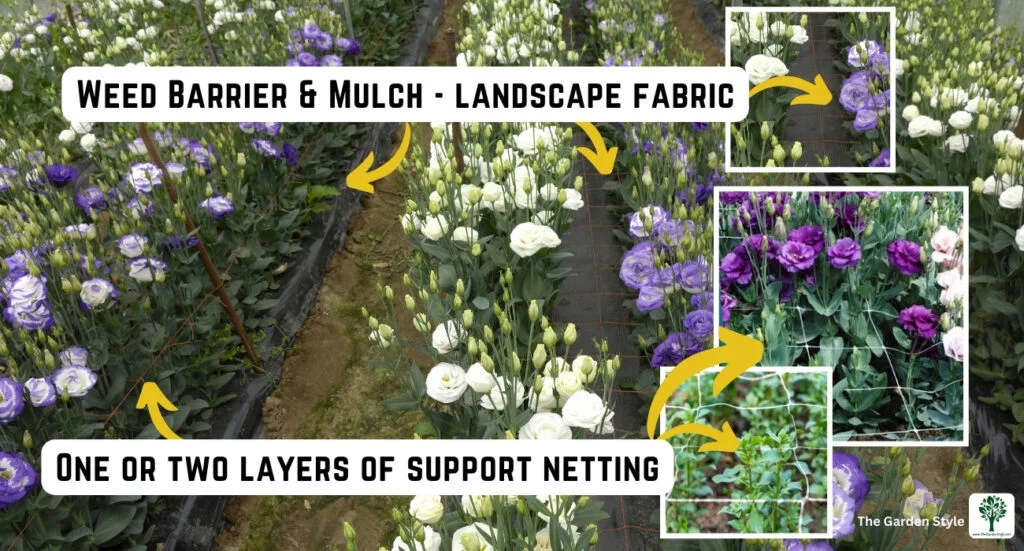
Mulching
Mulching can be beneficial for Lisianthus plants, regardless of the soil type, and cut flower growers in hot weather zones should be considered to retain moisture by reducing evaporation and helping to moderate soil temperature fluctuations. Mulching also prevents weeds, reducing competition for water, nutrients, and space.
For growing Lisianthus, the best mulch is one that helps retain soil moisture suppresses weeds and improves soil fertility without causing any harm to the plants. Organic mulches are generally preferred for Lisianthus cultivation, although the mulch option depends on your purpose. Here are some options and their pros and cons:
| Mulch Option | Large-Scale Flower Farm | Small-Scale Cut Flower Garden |
| Black Plastic Mulch | It is effective for weed suppression and moisture retention. Installation and removal require machinery, and it may not be suitable for all growing conditions. | Generally not practical due to labor-intensive installation and removal. |
| Landscape Fabric | Provides weed suppression and moisture retention. Durable and can be installed with machinery. Suitable for large-scale operations. | Effective for weed suppression and moisture retention. It can be installed manually in small areas. |
| Wood Chips/Bark Mulch | Organic option for weed suppression, moisture retention, and soil insulation. Slowly enriches the soil as it decomposes. It can be applied with machinery. | Provides weed suppression, moisture retention, and soil insulation. Suitable for small areas and can be applied manually. |
| Straw/Hay | Cost-effective option for weed suppression and moisture retention. Biodegradable and adds organic matter to the soil. It can be applied with machinery. | Cost-effective option for weed suppression and moisture retention. Suitable for small areas and can be applied manually. |
| Compost | Provides nutrients, weed suppression, and moisture retention. Beneficial for soil health and fertility. It can be applied with machinery. | Provides nutrients, weed suppression, and moisture retention. Suitable for small areas and can be applied manually. |
Watering
Lisianthus flowers prefer consistently moist soil, but not waterlogged conditions. Apply water deeply to encourage deep root growth. Watering deeply encourages the roots to grow downward, which helps the plants access moisture from deeper soil layers.
Try to water Lisianthus at the base of the plants to minimize wetting the foliage. Wet foliage can increase the risk of fungal diseases, particularly in humid conditions. Aim to keep the soil evenly moist, especially during the growing season and hot, dry weather. Avoid allowing the soil to dry out completely between watering, as this can stress the plants and lead to reduced flowering.
Regularly check the soil moisture level around Lisianthus plants by inserting your finger into the soil. Water when the top inch (2.5 centimeters) of soil feels dry to the touch. For an effective way to water Lisianthus, it is best to use a drip irrigation system.
Watering Lisianthus in the morning is generally recommended, as it allows the foliage to dry before evening, reducing the risk of fungal diseases. Avoid watering during the hottest part of the day to minimize water loss through evaporation.
Generally, Lisianthus plants may need watering 1-2 times per week during dry periods but adjust based on soil moisture levels and weather conditions.
Pest and Disease Control
While generally resilient, Lisianthus plants can be susceptible to common garden pests like aphids, thrips, and spider mites. Regularly inspect your plants and take appropriate action if necessary, such as using insecticidal soap or neem oil. Additionally, ensure good air circulation and avoid overhead watering to prevent fungal diseases like botrytis blight.
Fusarium is a major disease threat to Lisianthus, causing root rot. It is commonly found in most natural soils and particularly common when planting Lisianthus plugs. I would say the biggest cons of growing Lisianthus from plugs is how easy it is to have the disease. I’ve rarely seen this problem when growing Lisianthus from seeds, even when it’s needed to start indoors. To prevent this disease, always ensure good air circulation.
Traditional treatments like methyl bromide fumigation and soil steaming are environmentally problematic to eradicate Fusarium. Using biofungicides like Actinovate that coat roots can provide some protection against fusarium. Conventional fungicides labeled for greenhouse drench applications can also help prevent fusarium.
Harvesting Lisianthus Flowers
One of the most rewarding aspects of growing Lisianthus is harvesting their stunning blooms. Cut the flower stems when the bottom one or two rows of petals have fully unfurled, leaving at least two sets of leaves on the plant. Use sharp, clean pruners or scissors to make a clean cut, and immediately place the cut stems in clean water mixed with a floral preservative. This will help extend the vase life of your Lisianthus flowers, allowing you to enjoy their beauty for up to two weeks in a vase or arrangement.
When to Harvest Lisianthus
When determining the ideal time to harvest Lisianthus flowers, it’s crucial to rely on specific indicators rather than the “wiggle test,” which isn’t commonly recommended. Here’s a comprehensive guide to help you know when your Lisianthus blooms are ready for harvest:
- Flower Opening: Harvest Lisianthus stems when the bottom 1-2 rows of petals have fully opened on the terminal flower bud, while the upper buds may remain closed.
- Bud Development: Ensure the stem features 3-4 well-developed bursting buds, along with open flowers at the base. These upper buds will continue to bloom in the vase.
- Stem Length: Aim for stems measuring 12-24 inches from the soil line, depending on your desired length. Avoid waiting too long to prevent flower deterioration.
- Stem Rigidity: Test the stem by gently tugging it. A rigid stem that snaps back into place indicates good water uptake ability.
- Color Intensity: Look for vibrant coloration in the petals. Lisianthus flowers are most visually appealing when their colors are intense and fully developed.
- Texture: Feel the petals to ensure they are smooth and firm. Avoid harvesting Lisianthus flowers with wilted or damaged petals, as they may not last as long in the vase.
- Time of Day: Harvest Lisianthus flowers early in the morning or late in the evening when temperatures are cooler. This helps preserve their freshness and reduces the risk of wilting during transportation.
- Weather Conditions: Avoid harvesting Lisianthus flowers during periods of high humidity or immediately after rainfall. Wet conditions can increase the likelihood of mold or bacterial growth on the flowers.
- Stage of Growth: Ideally, harvest Lisianthus flowers when they are at the peak of their bloom. Flowers that are overly mature may have a shorter vase life and may not open fully once cut.
Commercial solutions stimulate bud development and aid vase life.
By considering these factors collectively, you can ensure that you harvest Lisianthus flowers at the perfect stage for maximum freshness and longevity in arrangements.
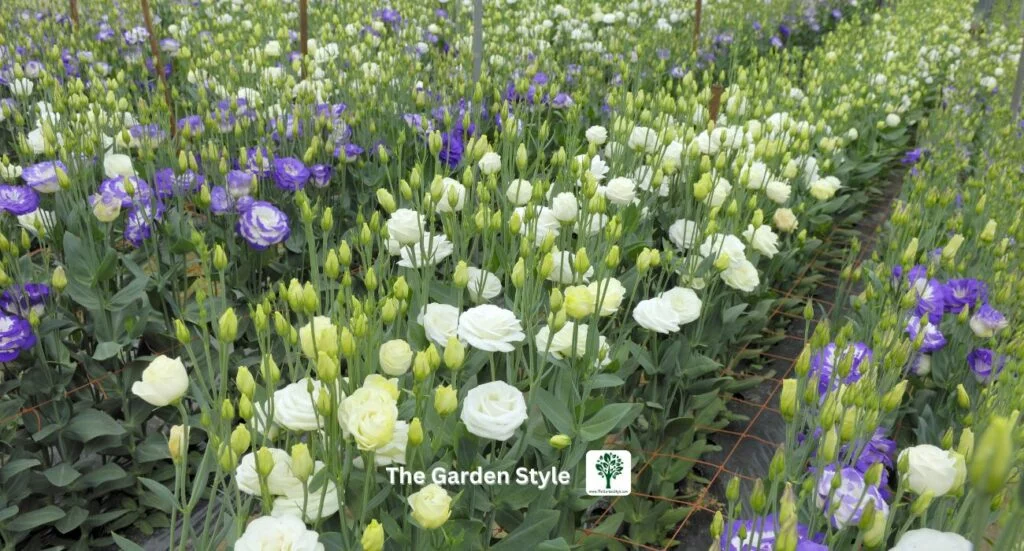
At A Glance: Key Steps and Tips for Growing Lisianthus from Seeds (Chart)
| Step | Tips |
| Seed Selection | Choose high-quality seeds from reputable suppliers |
| Germination | Provide warm temperatures (70°F to 75°F) and consistent moisture |
| Soil Mix | Use a well-draining seed-starting mix. |
| Sowing | Sow seeds on the surface and press gently into the medium. |
| Watering | Water from the bottom and maintain high humidity during germination |
| Thinning | Thin seedlings to 3-4 inches apart, leaving the strongest ones |
| Transplanting | Transplant to larger containers or garden at 6-8 inch spacing |
| Fertilizing | Use balanced, water-soluble fertilizer every two weeks. |
| Pinching | Pinch out growing tips to encourage bushier growth. |
| Staking | Provide stakes or cage supports for tall stems. |
| Pest Control | Monitor for pests and use organic controls if needed. |
| Disease Prevention | Ensure good air circulation and avoid overhead watering. |
| Harvesting | Cut stems when bottom petals unfurl, leaving 2 leaf sets. |
Is There Any Other Method To Grow Lisianthus Other Than Seeds?
Yes, there are a couple of other methods to grow Lisianthus besides starting them from seeds:
Propagation from cuttings
Propagation from cuttings Lisianthus can be propagated vegetatively through stem cuttings. Commercial growers often use this method to maintain specific cultivars. Here are the basic steps:
- Take 4-6 inch stem cuttings from a healthy Lisianthus plant, cutting just below a leaf node
- Remove the lower leaves and dip the cut end in a rooting hormone powder
- Plant the cuttings in a well-draining potting mix
- Keep the cuttings warm (70-75°F) and humid, and provide bright, indirect light
- Water when the soil surface becomes dry
- Cuttings should root in 4-6 weeks before transplanting
Propagating from cuttings ensures the new plants are genetically identical clones of the parent plant.
Division
Division of established plants If you already have Lisianthus plants growing in your garden, you can divide them to produce more plants. This method works best in warm climates where Lisianthus can be grown as a perennial:
- In early spring, before new growth begins, carefully dig up the entire Lisianthus plant
- Gently pull or cut the rootball into 2-3 sections, making sure each division has roots and stems
- Replant the divisions at the same soil depth in fresh, enriched garden soil
- Water well to settle the soil around the new plantings
Through division, you can multiply your existing Lisianthus plants each spring.
While starting from seed is most common, propagation by cuttings or division can be good options to obtain specific cultivars or expand your existing Lisianthus plants.
Recommended Reading: How to Start a Cut Flower Garden: Plan and Layout
Save this pin, come back easily, and recommend our expert guide for cutting flower growers to your friends; discover how to grow lisianthus from seed, plugs, and cuttings!
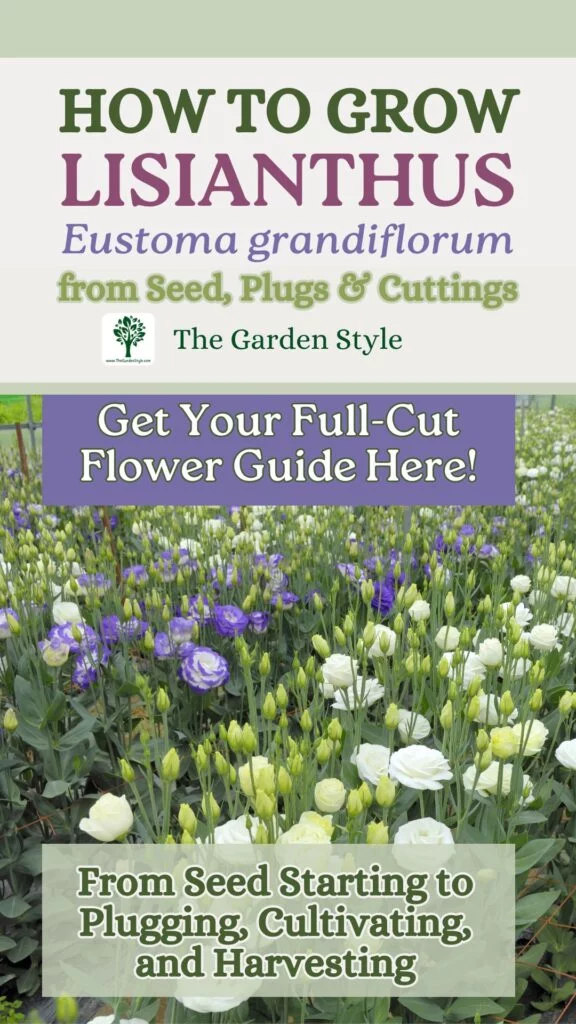
What Is The Best Method To Grow Lisianthus: From Seeds Or Cuttings? Pros and Cons
The best method to grow Lisianthus depends on your goals and preferences, but in general, starting from seed is recommended for most home gardeners. Here’s a comparison of the pros and cons of these two methods:
| Aspect | Growing from Seed | Growing from Cuttings |
| Pros | More economical | Faster time to bloom |
| Allows a wider variety of colors/cultivars | Ability to propagate specific cultivars | |
| Sturdier, more vigorous plants | Uniformity in commercial settings | |
| Rewarding experience | ||
| Cons | Longer time to bloom (20-24 weeks) | More expensive to purchase cuttings/mother plants. Usually sold as Lisianthus plugs (it may have higher risk of Fusarium disease) |
| Tricky germination, precise conditions required | Requires taking stem cuttings and rooting them | |
| More care is needed for the seedling stage | Limited to available cultivars |
For most home gardeners and flower farmers, especially those growing Lisianthus for cut flowers, starting from seed is the best choice. It provides more cultivar options, is more cost-effective, and allows you to experience the full life cycle. Seed-grown plants bloom later but tend to be robust.
However, if you want plants of a particular Lisianthus cultivar or need a quicker turnaround to bloom time, propagating from cuttings may be preferable, albeit more expensive initially. So, you can grow Lisianthus from cuttings. Deciding to pursue one growing method or another depends on your purpose, and you may want to combine them for profit.
With proper technique, both methods can produce outstanding Lisianthus plants. But for most hobby growers, the rewarding experience of growing from seed makes it the recommended best method overall.
Why Are Lisianthus So Profitable as A Cut Flower?
Lisianthus flowers are considered highly profitable as cut flowers for several reasons:
- Long vase life: Lisianthus blooms have an exceptional vase life of up to 2-3 weeks, much longer than many other popular cut flowers. That extended longevity makes them appealing to florists and consumers alike.
- High stem value: A single Lisianthus stem can produce multiple blooms, providing more value per stem compared to single-bloom flowers. Therefore, it multiplies the potential income from each plant.
- Year-round availability: With their ability to be grown as a greenhouse crop, Lisianthus can be produced year-round, providing a consistent supply to meet demand.
- Wide color range: Lisianthus are available in a beautiful array of colors, from pure whites to vibrant purples, pinks, and bicolor flowers. This variety caters to diverse consumer preferences.
- Unique appearance: The elegant rose-like blooms and ruffled double forms of Lisianthus offer a distinctive look that stands out in bouquets and arrangements.
- Pricing potential: Lisianthus commands higher prices than many common field-grown cut flowers due to their quality, novelty, and perceived value by consumers.
- Production efficiency: While initially slow to germinate, Lisianthus plants are relatively low-maintenance once established and can produce numerous high-value stems over an extended harvest period.
With their superior postharvest qualities, versatility in design, and strong customer appeal, Lisianthus represents an attractive, high-value crop for commercial cut flower growers to maximize profitability.
How Profitable Can Lisianthus Be for a Flower Farmer?
The profitability of selling Lisianthus, like any other flower, can vary greatly depending on several factors, such as the quality of the flowers, the market they’re sold into, the region, and the skill set.
Wholesale Pricing:
- Standard Single Lisianthus: $1.50 to $3.00 per stem.
- Mini-Double Lisianthus: $2.00 to $4.00 per stem.
- Standard Double Lisianthus: $2.50 to $5.00 per stem.
- Frill Lisianthus: $2.50 to $5.00 per stem.
- Exclusive Designer Lisianthus: Prices may vary based on availability and quality.
- Minimum stem length: 20 inches.
- Stem length: 24-36 inches (premium quality)
- Stem yield per plant: 10-15 stems (assuming good cultural practices)
- Available all year round.
- It is ideal for weddings, events, and special occasions due to its timeless and elegant appearance.
However, in some areas, pricing from a high-end wholesaler could range from $0.75 – $2 or more per stem, and pricing from regular wholesalers for a stem-like Lisianthus may be in the $0.20 – $0.60 range, as mentioned earlier. That changes all the calculations.
If you’re going to start a small business, make it profitable. I recommend reading my article, which lists the 23 Most Profitable Cut Flowers with pricing ranges, and, of course, includes Lisianthus flowers.
If you are seriously considering running a small business with your garden or starting a flower farm, you can take advantage of more than 100 tax deductions when you grow cut flowers as a business. As a flower farming business, you can deduct many expenses related to your operations. You can also deduct a portion of your start-up costs (up to $5,000) in the year you begin an active trade or business. Learn more about Business Income, Expenses, and Deductibles when Growing Cut Flowers for Profit. Also, you may want to take a look at my guide about Writing a Powerful Flower Farming Business Plan (with a Template PDF Included).
Frequently Asked Questions about How to Grow Lisianthus from Seeds
Lisianthus seeds typically take 10 to 14 days to germinate when provided with the ideal conditions, which include warm temperatures between 70°F and 75°F (21°C and 24°C) and consistent moisture.
Yes, Lisianthus plants can be successfully grown in pots and containers as long as they are provided with well-draining soil, ample sunlight, and consistent watering. Choose a container that is at least 12 inches (30 cm) deep and wide to accommodate their extensive root system. The rest of the growing steps are the same as explained in this article.
Depending on the variety, Lisianthus plants can grow anywhere from 12 to 36 inches (30 to 90 cm) tall. Taller varieties may require staking or cage support to prevent the stems from toppling over under the weight of the blooms.
In most climates, Lisianthus is grown annually, as it is not cold-hardy and will not survive freezing temperatures. However, in mild climates (USDA hardiness zones 8-10), Lisianthus can be grown as a short-lived perennial.
Lisianthus plants require consistent moisture, especially during the active growing and blooming periods. Water them deeply whenever the top inch of soil becomes dry, taking care not to overwater, as this can lead to root rot. Mulching around the plants can help retain moisture in the soil.
In regions with extended summers, growers may harvest 2 or 3 rounds of Lisianthus blooms, while those in northern areas may anticipate only one harvest per crop. Employ overhead watering for 2-3 weeks until roots are established and visible growth commences. Consistent fertilizing every 2-3 weeks with the proper NPK ratio tailored for lisianthus flowering will help maximize bud production and promote large, long-lasting blooms.
Readers from Zone 6 recently asked me about planting Lisianthus plugs. In Zone 6, which typically experiences cold winters and moderate summers, Lisianthus plugs can be planted outdoors after the danger of frost has passed and the soil has warmed up sufficiently.
The last frost date in Zone 6 usually falls in late April to early May, but it’s essential to consult local climate data and frost charts for your specific location to determine the exact timing. Once the soil temperature consistently reaches around 60°F (15°C) or higher, it’s generally safe to transplant Lisianthus plugs into the garden.
To get a head start on the growing season, you can also start Lisianthus plugs indoors 6 to 8 weeks before the last frost date. That allows the plants to establish roots and develop before being transplanted outdoors. Ensure the indoor environment provides adequate light, warmth, and moisture for optimal growth.
Overall, the aim is to transplant Lisianthus plugs outdoors in Zone 6 in late spring or early summer, ensuring that the soil has warmed up sufficiently and all risk of frost has passed.
Final Thoughts about Growing Lisianthus Flowers
Growing Lisianthus from seed is an incredibly rewarding experience for any gardener or flower enthusiast. With their exquisite blooms and long vase life, these stunning flowers are a true delight, whether gracing your garden or adorning indoor arrangements.
With the proper techniques for seed starting, transplanting, and providing the right growing conditions, Lisianthus makes an excellent, high-value cut flower. By following the steps outlined in this guide, you’ll be well-equipped to nurture these delicate beauties from the tiniest of seeds to magnificent, long-lasting blooms. Key advantages of growing Lisianthus from seed include more cultivar choices and well-branched sturdy plants, which are ideal for cutting gardens.
Embrace the joy of cultivating Lisianthus, and revel in the sense of accomplishment as you witness their journey from germination to breathtaking maturity.
I am sure you will find this gardening guide so helpful. Don’t hesitate to leave a comment below if you have a question.




